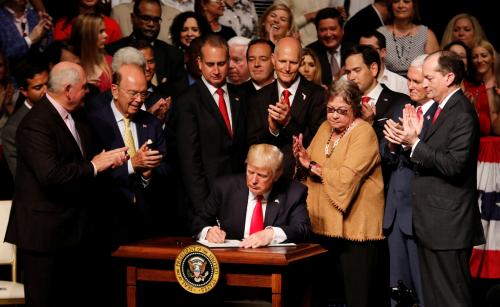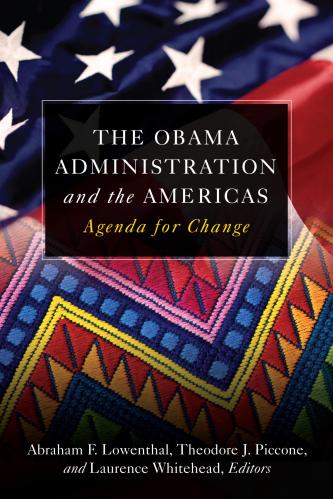The following post draws on research outlined in the December 2016 Brookings paper “Tourism in Cuba: Riding the wave toward sustainable prosperity,” co-authored by Richard Feinberg and Richard Newfarmer.
President Donald Trump’s new Cuba policy includes two measures aimed at reducing the flow of U.S. dollars to the Cuban state. The National Security Presidential Memorandum that he signed on stage in Miami in front of a raucous crowd of Cuban exiles prohibits U.S. visitors organizing their own individual people-to-people educational travel and prohibits financial transactions with Cuban state enterprises managed by the armed forces. What is likely to be the real economic effect of these measures?
Excluding Cuban Americans, the number of U.S. visitors in 2016 was 284,937—just 7 percent of Cuba’s 4.1 million foreign visitors that year. Many of those U.S. visitors went on trips that would still be allowed under the new rules; most are already traveling with groups tours, which are unaffected by the new regulations. Moreover, in general the biggest determinant of visits to tourism destinations is the availability of air transport, and Trump’s new measures do not affect either current or future civil air connections to Cuba.
If the ban on individualized people-to-people travel were to cut non-diaspora U.S. visits by, say, 20 percent, it would mean a reduction in the number of foreign visitors to Cuba of only one or two percent. Whether the decline in U.S. visitors is 10 percent, 20 percent or 50 percent depends on the actual severity of yet-to-be issued regulations, the dampening effects, if any, in other markets (e.g., Canada and Europe), and the response of the Cuban government. But whatever the number, the overall impact will be smaller than the Trump trumpeted headlines would suggest. This is not the end of the world for the Cuban economy.
This is not the end of the world for the Cuban economy.
According to a recent Brookings Institution study by Richard E. Feinberg and Richard Newfarmer, Tourism in Cuba: Riding the Wave toward Sustainable Prosperity, the non-state sector—private bed and breakfasts (casas particulares) rentals, restaurants, taxis, tour guides, etc.—receives about 31 percent of all tourist dollars. U.S. visitors on individualized trips are more likely to stay in casas particulares, take private cabs, and hire private guides than large organized groups, which are channeled through state tourist agencies and booked into state-owned hotels. Consequently, although President Trump’s policy purports to boost Cuba’s private sector, the prohibition on individualized people-to-people travel will likely hit the private sector hardest.
Gaviota, the military enterprise in the tourism sector, accounts for about 18,000 rooms (as of 2015) of about 71,000 total rooms available for international tourists—some 25 percent. If you discount the three-star hotels as not suitable for international tourists, that share rises to about 30 percent because Gaviota has a larger share of the four and five star rooms. Casas particulares account for almost the same number—some 16,000 rooms. Together, the four- and five-star non-military, state-owned hotel rooms and the private casas particulares have 42,000 rooms available for foreign visitors—ample space for accommodating U.S. visitors without patronizing enterprises managed by the military.
[T]he whole discussion of the military’s role in the tourism sector misses the point.
Even for spending that goes to Gaviota and its parent holding company, GAESA, our numbers suggest some 60 percent to 70 percent of this spending goes to Cuban workers for wages, to local suppliers, and maintenance and utility expenditures largely unaffiliated with the military. Consequently, measures intended to reduce tourist spending in the Gaviota complex mostly hurt ordinary Cubans.
In a way, the whole discussion of the military’s role in the tourism sector misses the point. U.S. dollars contributing to profits in a hotel run by Gaviota and dollar profits in a non-military, state-owned hotel end up in the same place: the Cuban Treasury, as state revenue. No doubt military enterprises, like other state enterprises, retain some revenue as reserves and for bureaucratic perquisites, but the central government, not the military, determines the ultimate allocation of state revenues in the national budget. It is hard to argue that the military’s market share in hotels gives them a claim on resources that their participation the Communist Party’s politburo does not already give them.
Nor will a reduction in the revenue generated by Gaviota impair the military’s political influence. The military has been, since 1959, a central pillar of the Cuban political system, second only to the Communist Party. The leadership of the armed forces is well-integrated into the leadership of the Communist Party, and the military’s influence rests on its historical role in the revolution, its internationalist missions abroad, and its embodiment of Cuban nationalism.
Another relevant point: Cubans largely control their own destiny in the tourism sector, despite the new U.S. sanctions, since the main constraints to the sector’s growth are Cuban domestic economic policies. Remaining competitive in tourism is a more significant challenge than U.S. sanctions. The last two decades have seen an erosion in Cuba’s competitiveness relative to other Caribbean destinations; the Cubans will have to raise the quality of their offerings if they are to realize tourism’s maximum benefit to national development. Feinberg and Newfarmer’s study outlines how they can do that.
In short, the sanctions President Trump has imposed on travel are not likely to put much of a near-term dent in the Cuban economy already weathering the loss of Venezuelan subsidies. Nor will they reduce the influence of the armed forces. But they will have a disproportionately negative impact on Cuba’s emerging private sector and on non-military employment in linkage industries—not to mention restricting Americans’ right to travel.






Commentary
The real economic impact of Trump’s sanctions on Cuba travel
June 21, 2017